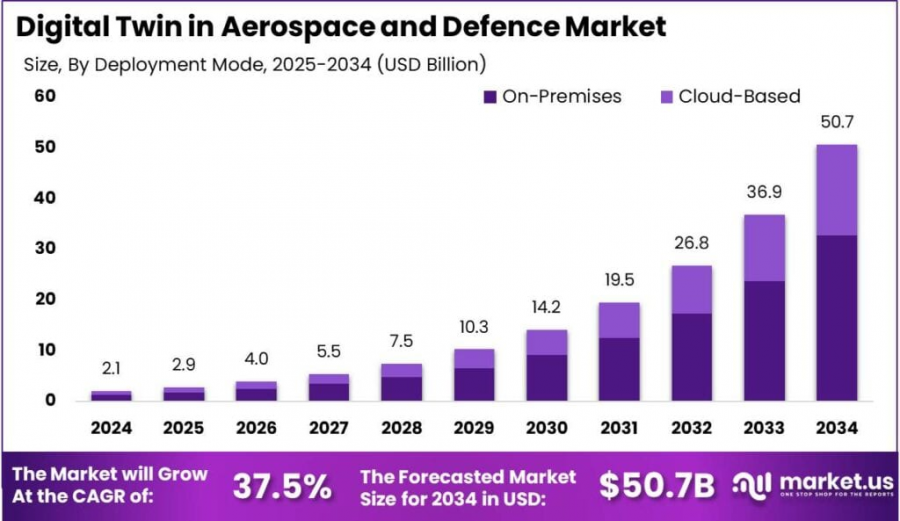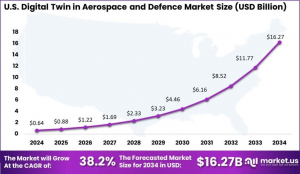
Digital Twin in Aerospace and Defence Market Huge Growth USD 50.7 billion by 2034, CAGR of 37.5%
In 2024, North America dominated the market, holding over 40.7% share and generating USD 8.85 billion in revenue...
SOUTH KOREA, SOUTH KOREA, SOUTH KOREA, February 3, 2025 /EINPresswire.com/ -- The digital twin market in the aerospace and defense sector is poised for exponential growth, projected to expand from USD 2.1 billion in 2024 to USD 50.7 billion by 2034, registering a compelling CAGR of 37.5%. A digital twin refers to a virtual model of a physical asset, system, or process, providing real-time analytics and insights.
In aerospace, digital twins are utilized for entire aircraft systems, including engines and airframes, to optimize design and improve predictive maintenance. This growth is spurred by the technology's ability to enhance simulation capabilities, minimizing physical testing costs and accelerating product development.
🔴 𝐃𝐨𝐰𝐧𝐥𝐨𝐚𝐝 𝐄𝐱𝐜𝐥𝐮𝐬𝐢𝐯𝐞 𝐒𝐚𝐦𝐩𝐥𝐞 𝐨𝐟 𝐭𝐡𝐢𝐬 𝐏𝐫𝐞𝐦𝐢𝐮𝐦 𝐑𝐞𝐩𝐨𝐫𝐭 @ https://market.us/report/digital-twin-in-aerospace-and-defence-market/request-sample/
As systems become increasingly complex, digital twins offer a sophisticated method to manage and optimize these systems, ensuring high reliability and performance. The aerospace and defense industries are leveraging these virtual models to extend asset lifespan and improve operational efficiency.
With the rise of digital transformation initiatives, the focus is on integrating advanced technologies like AI and IoT into digital twins, enabling more detailed simulations and analyses. This integration is expected to foster significant advancements in system efficiency and reliability, meeting the industry's stringent demands for precision and cost-effectiveness while addressing evolving operational challenges.
Key Takeaways
The Global Digital Twin Market in Aerospace and Defense is set to grow significantly. The market size is projected to reach USD 50.7 billion by 2034, up from USD 2.1 billion in 2024, representing a remarkable CAGR of 37.5% during the forecast period (2025–2034).
In 2024, North America dominated the market, holding over 40.7% share and generating USD 8.85 billion in revenue.
The U.S. Digital Twin Market in this sector exhibited a size of USD 0.6 billion in 2024 and is expected to grow at a slightly higher CAGR of 38.2% compared to the global rate.
The Component segment led the market in 2024, accounting for more than 52.8% of the total share, showcasing its critical role in the aerospace and defense digital twin ecosystem.
Deployment trends favored On-premise solutions, which captured more than 64.6% of the market share in 2024, highlighting organizations’ preference for localized infrastructure for sensitive data.
When analyzing business types, Large Enterprises dominated the market, holding over 72.7% share in 2024, reflecting the high adoption rate of digital twin technologies among major players in aerospace and defense.
For applications, Product Design and Development stood out, contributing to more than 25.2% of the market share in 2024. This underscores the growing reliance on digital twin technology for innovation and efficiency in designing cutting-edge aerospace and defense products.
🔴 𝐇𝐮𝐫𝐫𝐲 𝐄𝐱𝐜𝐥𝐮𝐬𝐢𝐯𝐞 𝐃𝐢𝐬𝐜𝐨𝐮𝐧𝐭 𝐅𝐨𝐫 𝐋𝐢𝐦𝐢𝐭𝐞𝐝 𝐏𝐞𝐫𝐢𝐨𝐝 𝐎𝐧𝐥𝐲 @ https://market.us/purchase-report/?report_id=138127
Experts Review
Experts forecast a robust expansion in the adoption of digital twin technologies within aerospace and defense due to their ability to reduce operational costs and enhance asset management. Key drivers include the push for digital transformation and the need for predictive maintenance solutions. The demand for real-time analytics has positioned digital twins as essential tools for improving system reliability and performance.
Investment opportunities are significant, though data security and privacy concerns present notable challenges. Advanced modeling capabilities enabled by digital twins aid organizations in minimizing risks associated with complex aerospace systems. The regulatory environment supports further digital twin integration, prompted by demands for enhanced operational efficiency and compliance with stringent safety standards.
Large enterprises in particular are capitalizing on these technologies to manage extensive systems and streamline operations, enhancing strategic planning and decision-making capabilities. The sector's transition towards digitalization is anticipated to increase as organizations seek to maximize the strategic benefits of implementing virtual models, ensuring systems' readiness and responsiveness in mission-critical scenarios.
🔴 𝐓𝐨 𝐆𝐚𝐢𝐧 𝐠𝐫𝐞𝐚𝐭𝐞𝐫 𝐢𝐧𝐬𝐢𝐠𝐡𝐭𝐬, 𝐑𝐞𝐪𝐮𝐞𝐬𝐭 𝐚 𝐬𝐚𝐦𝐩𝐥𝐞 𝐫𝐞𝐩𝐨𝐫𝐭 @ https://market.us/report/digital-twin-in-aerospace-and-defence-market/request-sample/
Report Segmentation
The report segments the digital twin market by solution type, deployment method, enterprise size, and application. Solution types include components, processes, and systems, with components holding a dominant 52.8% share in 2024, owing to their role in forming digital replicas of assets.
Deployment methods are categorized into cloud and on-premise, with on-premise particularly favored for its security and control in sensitive environments. For enterprise size, large enterprises dominate with a 72.7% share, underscoring their capacity to invest in comprehensive digital twin implementations.
The application sector comprises product design and development, predictive maintenance, business optimization, and space-based monitoring, among others. Product design and development is crucial, driving significant market shares due to its role in reducing prototyping costs and improving design accuracy.
The regional analysis highlights North America's leadership, attributed to strong technological infrastructure and strategic focus on aerospace innovations. The segmentation reflects how digital twin technologies are tailored to enhance various operational facets within aerospace and defense, offering unique solutions to distinct market needs and promoting broader adoption as technological capabilities advance and systems become more complex.
Key Market Segments
By Solution
Component
Process
System
By Deployment
Cloud
On-premise
By Enterprise Size
Large Enterprises
Small and Medium Enterprises (SMEs)
By Application
Product Design & Development
Predictive Maintenance
Business Optimization
Space-Based Monitoring
Others
🔴 𝐆𝐞𝐭 𝐭𝐡𝐞 𝐅𝐮𝐥𝐥 𝐑𝐞𝐩𝐨𝐫𝐭 𝐚𝐭 𝐄𝐱𝐜𝐥𝐮𝐬𝐢𝐯𝐞 𝐃𝐢𝐬𝐜𝐨𝐮𝐧𝐭 (𝐋𝐢𝐦𝐢𝐭𝐞𝐝 𝐏𝐞𝐫𝐢𝐨𝐝 𝐎𝐧𝐥𝐲) @ https://market.us/purchase-report/?report_id=138127
Drivers, Restraints, Challenges, and Opportunities
Drivers: The ability to conduct enhanced predictive maintenance is a key driver. Digital twins provide real-time monitoring and predictive analytics, helping organizations preemptively address maintenance needs, thereby minimizing downtime and extending equipment lifespan.
Restraints: Data security and privacy concerns are significant barriers. The use of continuous data streams poses vulnerability to cyber threats, necessitating robust cybersecurity measures to protect sensitive information, especially given the defense sector’s critical nature.
Challenges: Integrating digital twins with existing systems can be complex, requiring significant investment in infrastructure and expertise. Furthermore, ensuring seamless functionality and system compatibility presents ongoing challenges.
Opportunities: Advancements in IoT and AI bring substantial opportunities, facilitating detailed data collection and analysis. AI-driven models enhance predictive capabilities, allowing for more dynamic and accurate simulations. This technology fosters innovation in aerospace and defense operations, providing innovative solutions for modern challenges and operational needs.
Key Player Analysis
Leading the digital twin market in aerospace and defense are prominent players like IBM, Siemens, General Electric, and Dassault Systèmes. These companies not only supply digital twin technologies but are also pivotal in advancing the field through continued innovation. Siemens, for instance, expanded its offerings with industrial AI solutions that bolster digital twin capabilities.
IBM and General Electric leverage extensive research in machine learning and IoT to enhance digital twin applications across production and operational environments. Dassault Systèmes' 3DEXPERIENCE platform offers sophisticated modeling and simulation capabilities, further solidifying its position in the market.
By integrating advanced analytics and cloud solutions, these companies support the growing need for efficient, real-time data management and system optimization. Their strategic focus on collaborative projects and technological advancements drives the continual evolution of digital twin applications, contributing to more efficient and reliable aerospace and defense systems.
Top Key Players in the Market
ABB Group
Amazon Web Services, Inc.
ANSYS, Inc.
Autodesk Inc.
AVEVA Group plc
Bentley Systems Inc.
Dassault Systemes
General Electric
Hexagon AB
International Business Machines Corporation
Microsoft Corporation
PTC Inc.
Robert Bosch GmbH
Rockwell Automation
SAP SE
Siemens AG
Others
Recent Developments
Recent developments in the digital twin market underscore a trajectory toward extensive technological refinement and applications. In January 2025, Siemens showcased new AI and digital twin innovations at CES, including a collaboration with JetZero for advanced aircraft modeling.
Dassault Systèmes updated its 3DEXPERIENCE platform with features targeting aerospace and defense requirements in February 2025. This update focuses on improving system design precision and operational efficiency. In December 2024, PTC enhanced its ThingWorx platform by integrating AI capabilities, following the acquisition of an AI startup, to boost aerospace manufacturing processes.
Hexagon's Q2 2025 launch of a digital twin solution aimed at optimizing aircraft assembly lines highlights their commitment to integrating precision with advanced analytics. These developments reflect the sector's focus on leveraging digital twin technologies for enhanced product lifecycle management and operational efficiencies while addressing the evolving needs of aerospace and defense operations.
Conclusion
The digital twin market in aerospace and defense is set for remarkable growth, driven by advancements in AI, IoT, and cloud technologies. These technologies enhance predictive capabilities and operational efficiencies across complex systems. Despite challenges like data security, the market offers significant opportunities for innovation and optimization.
Major players like Siemens, IBM, and Dassault Systèmes are pivotal in driving these changes, contributing to more reliable and efficient aerospace systems. As industries increasingly incorporate digital twins, the technology is poised to transform operational paradigms, fostering improved design, maintenance, and strategic planning within the aerospace and defense sectors.
➤ 𝐄𝐱𝐩𝐥𝐨𝐫𝐞 𝐎𝐭𝐡𝐞𝐫 𝐈𝐧𝐭𝐞𝐫𝐞𝐬𝐭𝐞𝐝 𝐓𝐨𝐩𝐢𝐜𝐬
Online Exam Proctoring Market - https://market.us/report/online-exam-proctoring-market/
Multi-Channel Network (MCN) Market - https://market.us/report/multi-channel-network-mcn-market/
Commercial Payment Cards Market - https://market.us/report/commercial-payment-cards-market/
3D Printing Market - https://market.us/report/3d-printing-market/
AI In Fintech Market - https://market.us/report/ai-in-fintech-market/
Air Charter Broker Market - https://market.us/report/air-charter-broker-market/
Legal Process Outsourcing Market - https://market.us/report/legal-process-outsourcing-market/
AI-Powered Video Editing Software Market - https://market.us/report/ai-powered-video-editing-software-market/
Virtual Tour Market - https://market.us/report/virtual-tour-market/
Aviation MRO Market - https://market.us/report/africa-aviation-mro-market/
Lawrence John
Prudour
+91 91308 55334
Lawrence@prudour.com
Visit us on social media:
Facebook
LinkedIn
Distribution channels: Aviation & Aerospace Industry
Legal Disclaimer:
EIN Presswire provides this news content "as is" without warranty of any kind. We do not accept any responsibility or liability for the accuracy, content, images, videos, licenses, completeness, legality, or reliability of the information contained in this article. If you have any complaints or copyright issues related to this article, kindly contact the author above.
Submit your press release


